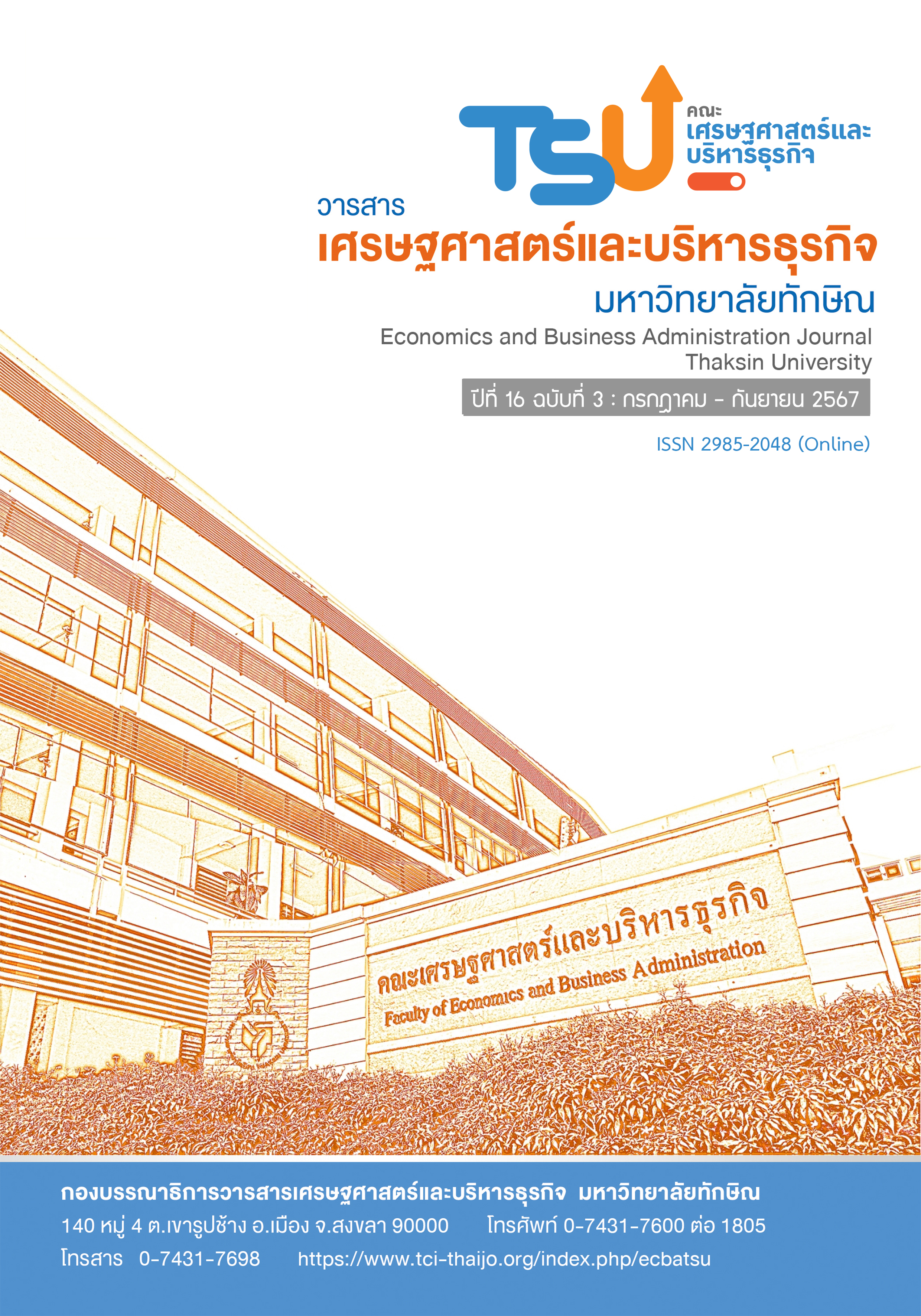Application of Reference Model for Supply Chain Operations and Activity-based Costing Systems to Reduce Costs and Logistics in the Drinking Water Production Process
DOI:
https://doi.org/10.55164/ecbajournal.v16i3.267324Keywords:
Supply Chain Operations Reference Model, Activity Base Cost, Logistics Cost, Nearest-Neighbor Heuristic, Saving AlgorithmAbstract
The purpose of this research was to study the reduction of logistics costs in the drinking water production process by applying the supply chain operation reference model (SCOR Model) to be used as a tool for analyzing the structured cost consideration process. which analysis of logistics costs The researcher used the activity-based cost system. A case study of a company in Makham Khu Sub-district, Nikhom Phatthana District, Rayong Province to be a guideline for reducing the cost of drinking water production. The researcher collected data and interviewed entrepreneurs. From the study and applying the Activity Based Costing system to the cost analysis, it was found that transportation activities had the highest cost of 329,630 baht, followed by manufacturing activities at 305,291.79 baht, tank cleaning activities at 278,826 baht, storage activities at 48,711 baht, and procurement activities at 41,576 baht. The above costs are based on the analysis of the activity-based cost system so that operators can see the overall picture of production costs even more. and from the cost analysis, resultsThe researcher has applied a solution to the problem of transport activity costs. by developing and reducing costs. It has adopted the closest answer method and the total distance method of the transportation route. These guidelines will help operators to improve and plan transportation routes. as well as can reduce fuel costs and as a way to reduce costs that can increase profits affecting the efficiency of business operations.
References
American Production and Inventory Control Society. (2018). Supply Chain Operations Reference Model. Chicago: APICS.
Atikomrattanakul, P., & Ratanachum P. (2017). Activity Cost Analysis for Road Freight Work: Case Study: Cement Transport Company. KMUTT Research and Development Journal, 40(1), 117-136.
Banomyong, R., Supatn, N., & Chaisurayakarn, S. (2008). ABC Logistics Cost Analysis (Logistics Cost Analysis by ABC Logistics Cost Analysis). Japan External Trade Organization (JETRO).
Beasley, J.E. (1983). Route First-Cluster Second Method for Vehicle Routing. Omega, 11(4), 403-8.
Bowersox, D.J., Closs, D.J., Cooper, M.B., & Bowersox, J.C. (2013). Supply Chain Logistics Management. (4th ed.). McGraw-Hill. Singapore.
Boonsam P., Sutthikarnnarunai N., & Ratanawong W. (2011). Cargo Grouping and Routing, Transportation with Multiple Distribution Centers: A Case Study of Cash Transfers. UTCC Engineering Research Papers [Internet]. 2011 [cited 2019 April 5]. Available from: http://eprints.utcc.ac.th/1751/1/1751fulltext.pdf.
Chaiwongsakda, N., Ananaue, P., Jeenaboonrueang, N., Winyangkul, S., Sinnarong, K., Jakkaew, T., & Srisawang, N. (2015). Vehicle Routing by using a Saving Algorithm and the Traveling Salesman Problem: A Case Study of a Drinking Water Factory. Thai Journal of Operations Research, 3(1), 51-61.
Chanasit, C., & Yaowsuwanchai, S. (2013). Development of Freight Forwarding Program, Case Study Service Provider Freight Business. WMS Journal of Management Walailak University, 2(1), 55-69.
Chiouur K., (2017). Vehicle Routing Problem with Stochastic Demand. Journal of Air Navigation, Science and Technology, 13(13), 19-24.
Chunchaiphak, P. (2018). School Bus Routing: A Case Study of Prasitsuksasongkroh School. Master of Engineering Thesis, Ubon Ratchathani University.
Clarke, G. & Wright, J. (1964). Scheduling of Vehicles from a Central Depot to a Number of Delivery Points. Operations Research. 12(4). 568-581.
Fongsin, P. (2015). Logistics Cost Analysis of Corn Farming with Animal-based Cost System, Case Study, Muang District, Uttaradit Province. Uttaradit Rajabhat University.
Kasamtaranan, N., & Tiewtong, H. (2019). Routing for Gasoline Transportation: A Case Study of Gasoline Transport Service Company. Interdisciplinary Sripatum Chonburi Journal, 6(2), 91- 98.
Kulkarni, S. , Sohani, N. , & Sehta, N. (2014). Capacitated Vehicle Routing using Nearest Neighbor Algorithm in Supply Chain. International Journal of Engineering Research & Technology, 3(5), 1331-1334.
Kongkaew, P., & Wasusri, T.(2017). Heuristic; Routing; Pickup and Delivery; Visual Basic Application (VBA). Journal of King Mongkut's University of Technology North Bangkok, 27(1), 111-23.
Pitacaso, R. (2011). Metaheuristic to Solve the Problems of Production Planning and Logistics Management. Bangkok: Technology Promotion Association (Thailand-Japan).
Phanphiphat, P., & Khemavuk, P. (2019). Vehicle Routing Arrangement of Heavy Trucks for Bulk and Sack Products: A Case Study of Transportation. Kasem Bundit Engineering Journal, 9(1), 136- 151.
Rattanapongporn, K. , & Rahotan, J. (2016). Vehicle Routing for Delivery of the Transportation Car Service: A Case Study of Sin Chai Auto Limited Partnership. Sripatum Chonburi Journal, 12(4), 55-64.
Saendee, P., Chamnanmor, A., & Chanta, S. (2014). The Study of the Route of Transporting the Flood Victims from Hazardous Areas at High Water Levels, Case Study: Tambon Lat Sawai, Lamlukka District, Pathum Thani Province. Journal of Industrial Education, 8(1), 61-71.
Sangdee, K., & Jomsonthia, M., (2020). Cost Analysis of Animal Feed Transportation by Technique. Activity-Based Cost Analysis, Case Study, Animal Feeding Company. Graduate Studies Journal Valai Alongkorn Rajabhat University Nationals, 14(2), 14-27.
Si Mueang, K. (2007). Finding the Number of Trucks that are Suitable for Transportation of Goods in the Retail Business: A Case Study of Tops Supermarket. Master of Engineering Thesis, King Mongkut's University of Technology North Bangkok
Sueni, K. (2020). The Routes Transportation by Comparison between using the Saving Algorithm and the Nearest Neighbor Algorithm. Economics and Business Administration Journal Thaksin University, 12(2), 1-14.
Supakdee, K., Nantasamroeng, N., & Pitakaso, R., (2015). Solving a Vehicle Routing Problem for Medical Equipment Maintenance by Saving Algorithms: A Case Study of Ubon Ratchathani Provincial Health Office. Journal of Narathiwat Rajanagarindra, 7(2), 23-36.
Supply-Chain Council. (2006), Supply - Chain Operations Reference Model Version 11.0, available at: http://www.supplychain.org (accessed 16th August 2006).
Taengsaengjan, R., (2015). An Ant Colony Optimization for Vehicle Routing Problem with Time Windows and Shift Time Limit [thesis]. Pathumthani: Thammasat University.
Toommanon, V. (2001). Activity-based Costing. Ionic, Bangkok.
Yongpisanphob, W., (2022). Business/Industry Trends 2022-2024: Beverage Industry. [Online system]. Source: https://www.krungsri.com/th/research/industry/industry-outlook/Food-Beverage/Beverage/IO/io-beverage-2022.
Downloads
Published
How to Cite
Issue
Section
License
Copyright (c) 2024 Faculty of Economics and Business Administration, Thaksin University

This work is licensed under a Creative Commons Attribution-NonCommercial-NoDerivatives 4.0 International License.




